15 Types of Bonsai Trees That Are Perfect for Beginners
These varieties are some of the easiest to train using the art of bonsai.
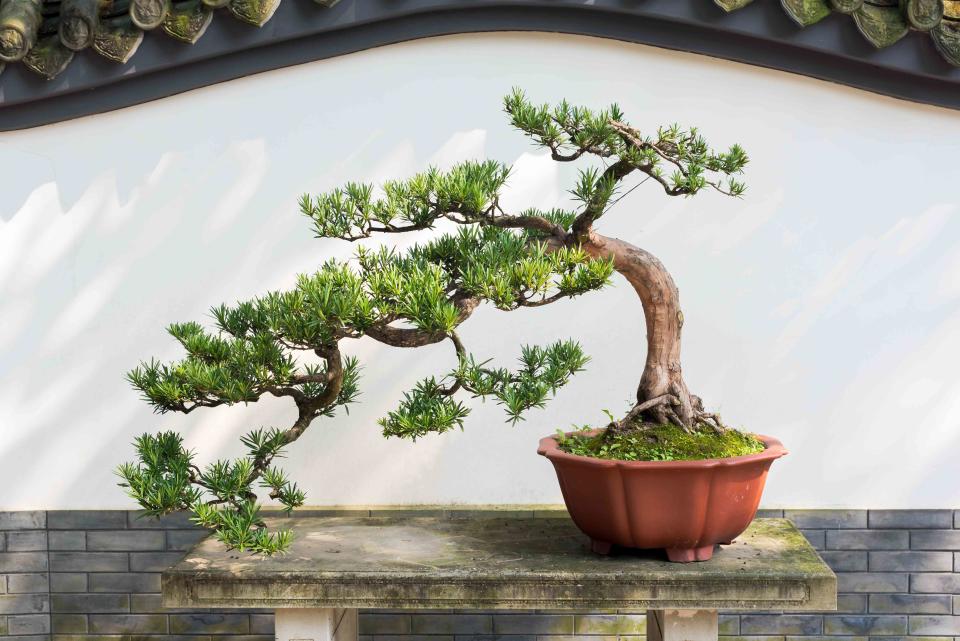
Getty Images
If you've ever marveled over a bonsai tree, you probably assumed it's an art best left to the experts. And while it does take some patience and rule-following, bonsai is absolutely beginner-friendly, especially when you start with the right type of bonsai tree.
What Is Bonsai?
Bonsai is an ancient Japanese growing method that involves trimming and pruning miniature trees to look full-sized—and almost any branching tree can be trained as a bonsai. Whether you've been practicing for a while or are just getting started, Jennifer Price, a professional bonsai artist based in Chicago, recommends connecting with a nearby club through the American Bonsai Society. You're never too inexperienced to join, she says. "When I teach throughout the country, what I notice is how warm and welcoming clubs are to new people. And a lot of clubs have mentorship programs," she says.
How to Grow Bonsai Trees
The biggest surprise to most newcomers is that bonsai trees aren't indoor trees. "The rule number one is that bonsai trees grow outdoors," says Michael Roberts, a respected bonsai artist and the president of the Golden State Bonsai Federation, explaining that outdoor trees make the best bonsai candidates but also need to be grown outside to maintain their health and strength. The way you care for your bonsai tree will depend on where you live and what type of tree you choose. Generally speaking, all bonsai trees require protection from extreme weather, and deciduous bonsai trees need a period of dormancy.
Northern bonsai artists manage this by placing their trees in an unheated garage or structure or in a cold frame on a protected side of the house with a bed of mulch for protection against wind and winter's coldest temperatures says Price. Dormant trees only need water when soil dries out and should be kept cool, even on warm winter days.
The Best Bonsai Tree Types for Beginners
If you've decided to begin the art of working with bonsai trees, which ones are best to start with? "For beginners eager to delve into the world of bonsai, certain species offer a gentler learning curve due to their resilience and less demanding care requirements," says Tony O'Neill, a seasoned gardener, founder of Simplify Gardening, and author of many books on the topic.
While you can purchase a bonsai tree at big box stores, a dedicated bonsai nursery is the best place to start, our experts say. Here are their recommendations for types of bonsai trees that work well for beginners.
Related: How to Grow, Care for, and Shape a Bonsai Tree
Pine
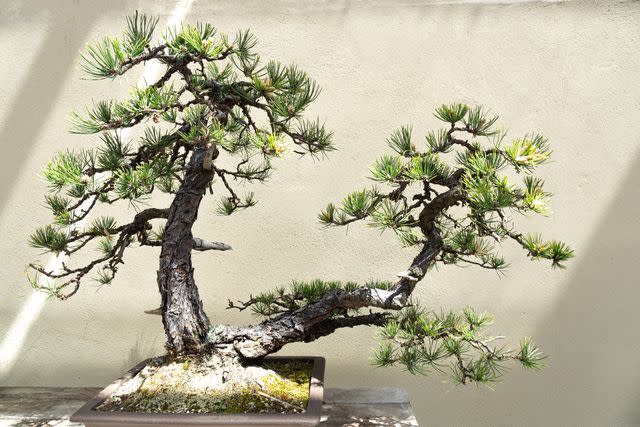
Renata Tyburczy / Getty Images
When you initially think of a bonsai tree, pine bonsais are likely the classic version that first comes to mind. "Pine bonsai trees have a graceful and majestic form that makes them stand out among other bonsai varieties," says Susan Brandt, co-founder of Blooming Secrets. "They often exhibit sweeping branches that curve upwards or cascade downwards, creating an exquisite silhouette that resembles their full-sized counterparts found in nature."
While these beauties can be grown indoors, they do best when grown outdoors. "They're best suited to outdoor conditions where they can experience seasonal changes, vital for their health and dormancy cycles," says O'Neill. Pine bonsai are particularly hardy and adaptable, making them great for both beginners and experts alike.
Zones: 3 to 8; provide winter care appropriate for your location
Watering: Water them when the top layer of soil feels slightly dry
Soil: Well-draining, slightly acidic soil
Light: Full sun
Japanese Maple
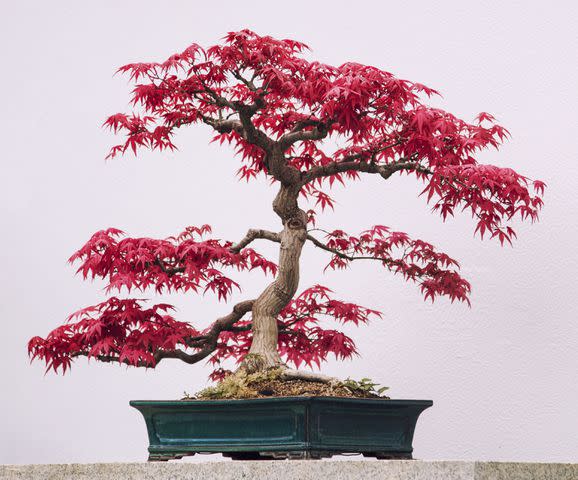
aleroy4 / Getty Images
Japanese Maple bonsai trees feature stunning little leaves that change as the seasons change. "In the spring, new leaves emerge in vibrant hues, transitioning to lush greens in summer," says Brandt. "As autumn arrives, these trees transform into breathtaking displays of fiery reds, oranges, and yellows before shedding their leaves in winter."
This one requires a bit more attention, according to Brandt, but it can still work well as a beginner bonsai tree. "While Japanese Maple bonsai require more attention, they offer stunning foliage colors and an elegant appearance," she says. "With proper care, they can thrive in both indoor and outdoor settings."
"They prefer a position with dappled sunlight to protect their leaves from scorching and require a well-draining soil that's kept evenly moist," says O'Neill. "Sensitive to both under and over-watering, they demand attentiveness, making them a beautiful, though more hands-on, bonsai choice."
Tips
"Use a watering can or spray bottle to gently water the tree, ensuring that water reaches all parts of the root system," says Brandt.
Zones: 5 to 8; provide winter care appropriate for your location
Watering: Water them when the top inch of soil feels slightly dry to the touch
Soil: Well-draining, slightly acidic soil that retains some moisture
Light: Bright but indirect sunlight
Japanese Cherry Blossom
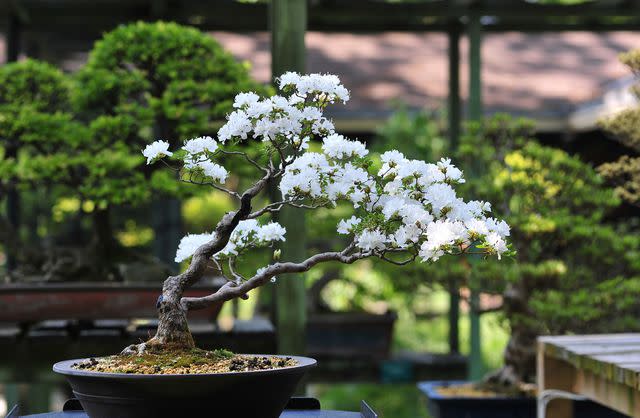
Carlo A / Getty Images
Also known as Sakura bonsai, the Japanese cherry blossom bonsai is beautifully delicate, with soft white and pink blossoms that bloom for just a short period in the spring. "Its flowering nature necessitates careful attention to watering and feeding, especially during its growth and bloom cycles," says O'Neill.
Keep this tree in partial sun, and be sure to protect it from the full afternoon sun as such intense sunlight can burn the delicate flowers and leaves.
Zones: 5 to 8; provide winter care appropriate for your location
Watering: Water them when the top layer of soil drys out; this plant likes to be kept moist and humid but never waterlogged
Soil: Well-draining, slightly acidic soil kept moist
Light: Partial sun
Weeping Fig
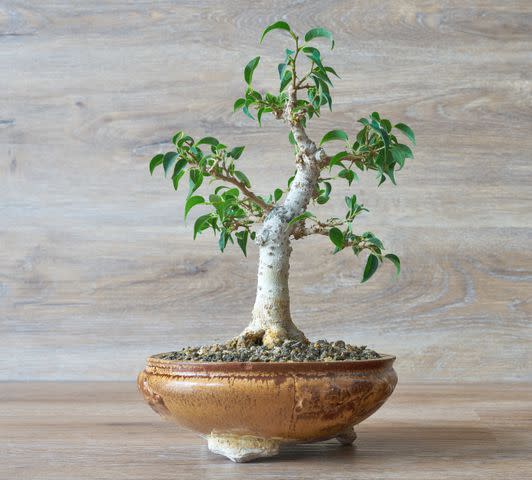
Heiko119 / Getty Images
The weeping fig is a great choice for beginners who want to keep a bonsai tree indoors. It's also pretty resilient and can tolerate those who might have some trouble remembering to water them consistently. "Unlike some other bonsai species, the weeping fig can thrive indoors with proper care," says Brandt. "It adapts well to lower light levels commonly found in homes or offices, making it an ideal choice for indoor gardening enthusiasts."
Zones: 10 and 11
Watering: Moderate watering when the soil begins to dry, plus regular misting for leaf health
Soil: Well-draining potting mix
Light: Part sun (preferring the morning sun) or bright indirect light if grown indoors
Jade
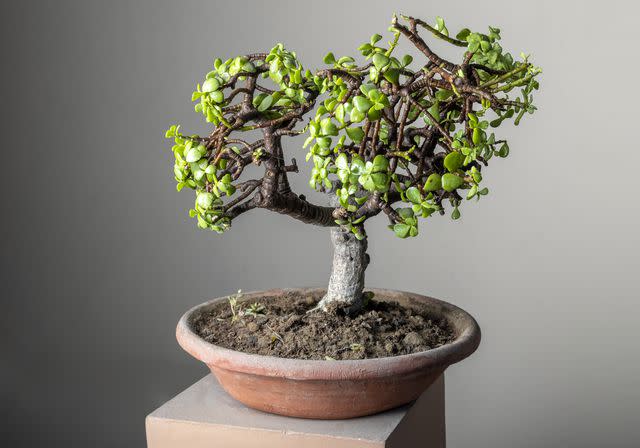
prabhjits / Getty Images
The jade bonsai is another great indoor tree option because they don't tolerate the cold very well. They are also incredibly tolerant for beginners to try their hand on, as they are not very sensitive to watering mistakes. "Jade trees make great beginner bonsai because the trees have thick trunks and fleshy leaves that store water, reducing the risk of under or over-watering mistakes," says Brandt.
Zones: 10 and 11 (relocate the plant indoors immediately if temperatures drop below freezing)
Watering: Allow the soil to become moderately dry before thoroughly watering once or twice a week
Soil: Well-draining soil
Light: Full sun
Related: 3 Ways to Propagate a Jade Plant
Bougainvillea
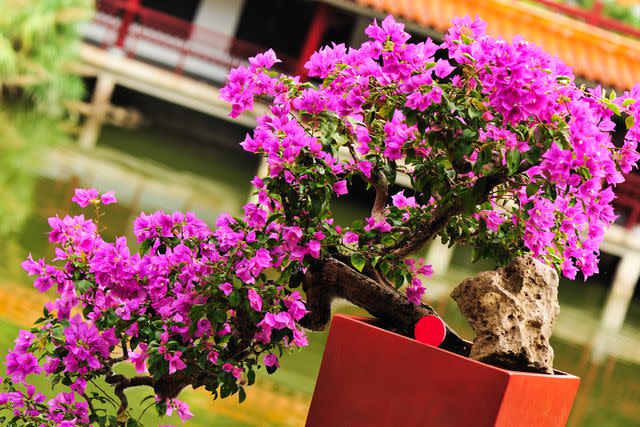
lzf / GETTY IMAGES
This evergreen shrub grows quickly and tolerates pruning well, making it a good beginner option. It also erupts in magenta, purple, yellow, or red flowers, adding a super showy dynamic to your bonsai art.
Zones: 9 to 11; provide winter care appropriate for your location
Watering: Keep soil evenly moist but not soggy in summer; water deeply and allow to dry out between waterings
Soil: Rich, well-draining soil
Light: Full sun
Boxwood
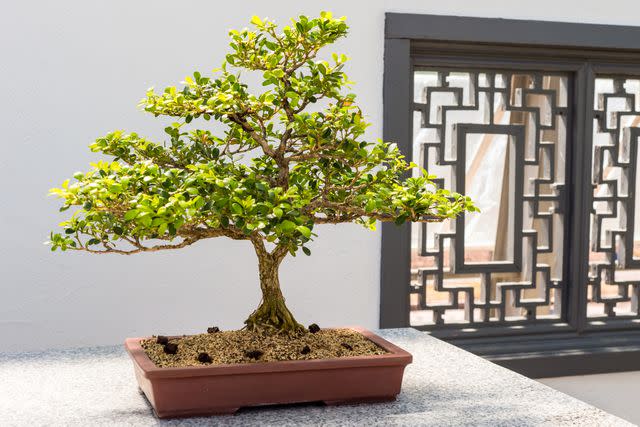
MarcBruxelle / GETTY IMAGES
With its hardy growth habits and high trimming tolerance, Buxos is an excellent type of bonsai tree for beginners. It also has small leaves, fissured bark, twisted branches, and shallow surface roots that lend themselves to the art form. "With patience and time, you can create little miniature 'oaks' out of boxwoods," Roberts says. "And it's a fairly inexpensive material to start with."
Zones: 6 to 8; provide protection from wind; provide winter care appropriate for your location
Watering: Water deeply, allowing soil to dry slightly between waterings
Soil: Loamy, well-draining soil
Light: Sun (with dappled afternoon shade) to part shade
Bald Cypress
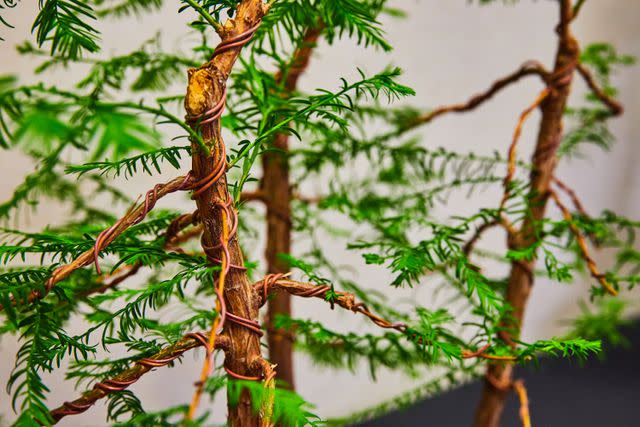
Nicholas Klein / GETTY IMAGES
Artists value Taxodium distichum for its "cypress knees," or woody structures above the root system, and distinctive flat upper canopy. Its soft green needles evolve to spectacular shades of yellow and auburn in autumn before shedding for the winter.
While it's a great choice for bonsai beginners in warmer climates, you'll find it more challenging if your temperatures drop below 25 degrees Fahrenheit. "People up North do have them, but in winter you've got to go through some pretty rigorous setups to keep that tree happy," Price says.
Zones: 5 to 10; provide winter care appropriate for your location
Watering: Water frequently to keep soil moist to wet, and use a humidity tray, especially in summer
Soil: Moist, acidic soil
Light: Sun
Chinese Elm
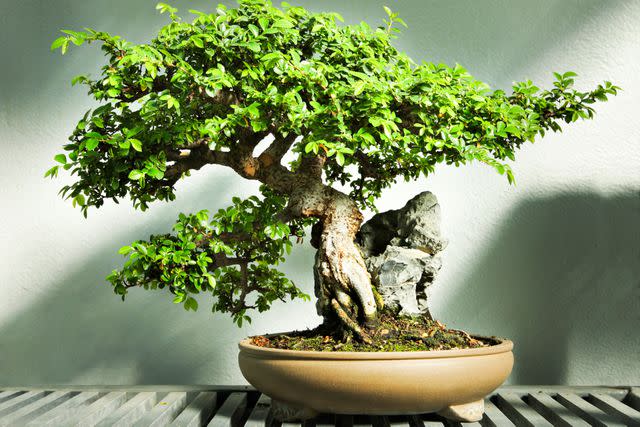
NicolasMcComber / GETTY IMAGES
Also known as the lacebark elm, Ulmus parvifolia thrives indoors and out and adapts well to pruning and shaping, making it a good option for both beginners and experienced artists. "It is hardy, adaptable, and forgiving, making it a great choice for those new to bonsai," says Brandt.
Its bark displays a good deal of character, with shades of gray, brown, green, and gray adding interest to the plant's rounded shape.
Zones: 4 to 9; provide winter care appropriate for your location
Watering: Water infrequently but deeply
Soil: Well-draining soil
Light: Sun or partial shade
Related: 10 Indoor Trees That Thrive in Low Light
Crape Myrtle
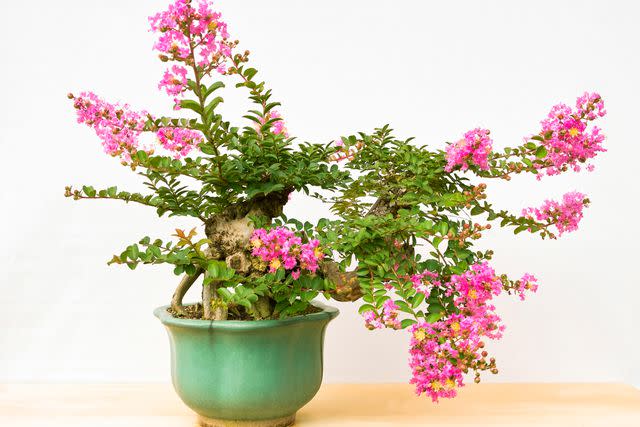
gyro / GETTY IMAGES
Another good beginner tree, Lagerstroemia indica is relatively easy to train and care for. "It gets cool little flowers in late summer, and it has what I would call almost a translucent bark that's green and red and tan, all at the same time. It's really gorgeous," says Roberts.
Zones: 6 to 9; provide winter care appropriate for your location
Watering: Water frequently and use a humidity tray in summer; limit water during winter dormancy
Soil: Rich, well-draining soil
Light: Sun
Desert Rose
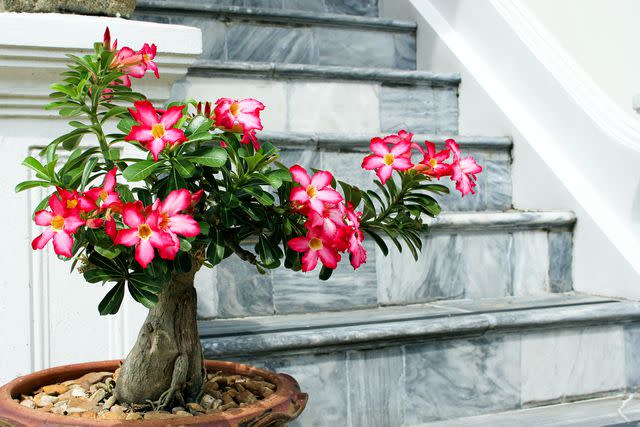
Vincent Jary / GETTY IMAGES
Native to tropical Africa and the Arabian Peninsula, succulent Adenium obesum is a forgiving beginner bonsai tree. Price loves its stunning bell-shaped flowers, which you can find in red, pink, or purple. A bulbous trunk, twisted branches, and gray-green leaves add character.
Zones: 11 to 12; provide winter care appropriate for your location
Watering: Water infrequently, allowing soil to dry out a bit between waterings.
Soil: Sandy, well-draining soil
Light: Sun to part shade
Ficus
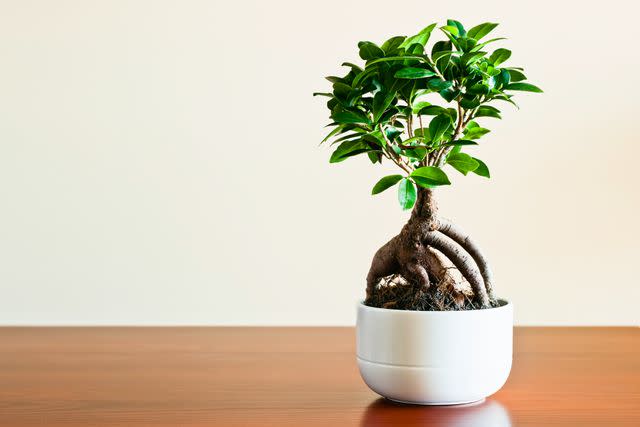
Photojope / GETTY IMAGES
Among the most popular trees for bonsai beginners, Ficus is hardy and tolerant of lower light. It's also less meticulous about watering than other bonsai varieties. According to O'Neill, a ficus bonsai is a very robust and forgiving tree to start with. "It adapts well to indoor conditions, requiring bright, indirect light and moderate watering, making it a very manageable species for novices," he says.
One of its best qualities is its aerial, or above-ground, roots "that are very Jurassic Park-looking," Price says. "They're what you might see if you were walking through a tropical forest region in India or in Asia and saw this tree in nature."
Small leaves also help give a Ficus bonsai the appearance of a giant tree in miniature.
Zones: 6 through 11; appreciates being outdoors in summer but can be grown indoors year-round with proper lighting; provide winter care appropriate for your location
Watering: Keep soil moist; boost humidity to develop aerial roots
Soil: Rich, well-draining soil
Light: Bright, indirect to partial sun
Juniper
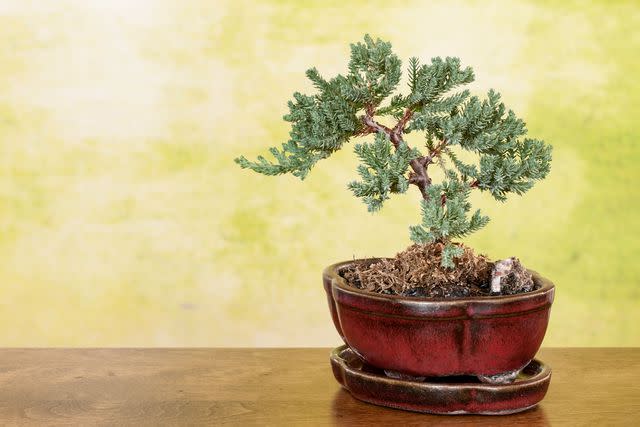
Liliboas / GETTY IMAGES
Junipers are a popular type of bonsai tree for beginners because they respond well to pruning and aging techniques, Price and Roberts say.
It is also pretty tolerant of a range of gardening conditions, another reason it's a good choice for a beginner. "Known for its hardiness and the beautiful, intricate shapes it can be trained into, the Juniper bonsai thrives outdoors where it can receive plenty of sunlight," O'Neill says.
Another plus: No matter where you live in the U.S., you can probably find a juniper that will do well in your climate. Foliage comes in two distinctive types: needle-like and scale.
Zones: 3 through 9; provide winter care appropriate for your location
Water: Water frequently but allow soil to dry between waterings
Soil: Rich, well-draining, loose soil
Light: Bright, indirect light
Rosemary
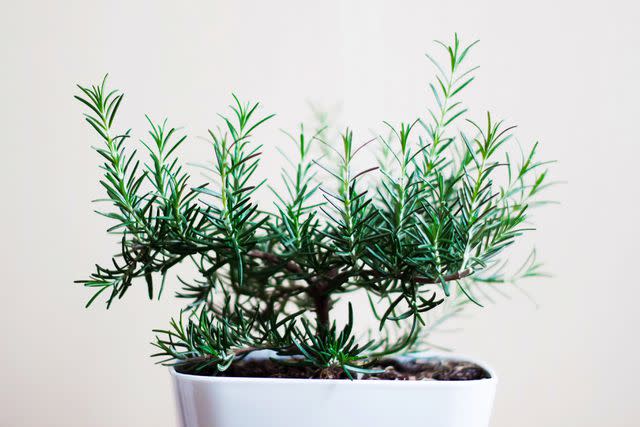
KseniaMay / GETTY IMAGES
This hardy, popular herb works surprisingly well for bonsai, and its ability to take a lot of pruning makes it a great choice for beginners. Its fibrous bark sheds a bit, giving the plant the distinctive and desired old-tree look, and its blue-green foliage has a pleasant evergreen scent when trimmed.
Zones: 8 to 10; prefers a dry environment at 55 to 85 degrees, but can take heat; provide winter care appropriate for your location
Watering: Water when the top inch or two of soil is dry, keeping soil moist but never soggy
Soil: Sandy, well-draining soil
Light: Sun
Trident Maple
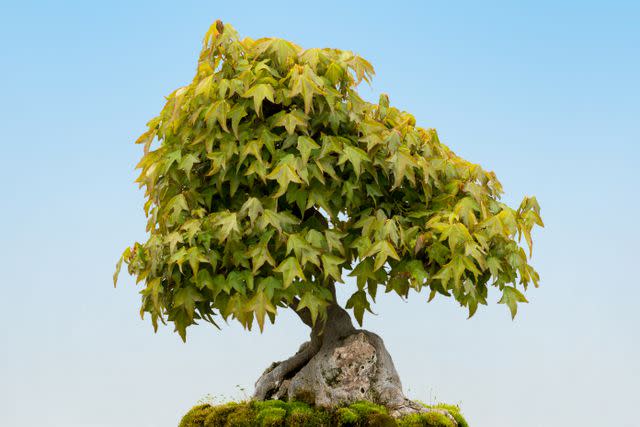
gnagel / GETTY IMAGES
Native to China and Japan, Acer buergerianum makes a good beginner bonsai. "They are vigorous and can build a fat trunk, quickly giving the appearance of character and age," Price says. Small leaves and a rough trunk also make it a popular choice, she adds. This tree also tolerates pruning well, accepts imperfect watering, and isn't hard to overwinter. Adding to your art, its deep green leaves will evolve to orange and red in fall.
Zones: 4 to 9; provide winter care appropriate for your location
Watering: Water daily in summer, less in other seasons
Soil: Any good quality, well-draining potting soil
Light: Sun with afternoon shade to protect from scorching, especially in hot regions
Read the original article on Martha Stewart.

